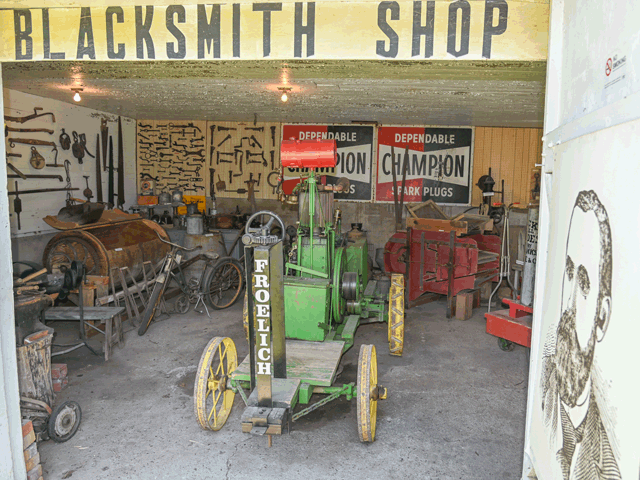Wilde's Favorite Story of 2022
Froelich Tractor and 1890s Village Museum: A Must See for Many Reasons
Editor's Note:
The turn to winter traditionally has us thinking back over the year that was. Here in the DTN/Progressive Farmer newsroom, we're also prone to look back on the accomplishments, the challenges, and the things that didn't turn out as planned. In that vein, we again asked our reporters and editors to look back at some of their favorite stories from the year. The pieces range from hard-hitting investigative journalism, to heart-tugging stories of loss, to the fun discoveries that can be found on farmsteads and small towns. We hope you enjoy our writers' favorites, with today's story by Matthew Wilde.
**
ANKENY, Iowa (DTN) -- I drove past the Froelich Tractor and 1890s Village Museum almost every summer weekend for the past decade while camping in northeast Iowa. I never stopped but would usually mutter to myself that I need to check that place out.
My excuse for not visiting the tiny unincorporated town of Froelich, better known as Tractor Town USA, and its main attraction was it's so close I can do it any time. It's still baffling to me why I hadn't, since I'm a history buff and can spend hours in a museum, often to the consternation of my family, reading signs that explain artifacts on display. Ag history is especially fascinating as a farm kid and ag journalist.
I finally took time to visit this summer and was blown away by what I saw and learned. I was also saddened to learn that only about 1,000 people visit the birthplace of the gasoline-powered traction engine (later known as a tractor) annually and learn first-hand how John Froelich's invention changed the world. Maybe too many people felt as I did and that they would get around to it someday.
"It's (attendance) not a lot, but we're continually working to get the word out," said Denise Schutte, executive director of the Froelich Foundation for the Preservation of Farm Tractor History Inc. "This is the place people will get the real story (about John Froelich and his tractor)."
P[L1] D[0x0] M[300x250] OOP[F] ADUNIT[] T[]
The story of John Froelich, a brilliant inventor and visionary who understood gasoline-powered tractors were the future of agriculture and not steam-power and horses, and the community named after John's father, Henry, needed to be told. Find it at www.dtnpf.com/agriculture/web/ag/news/article/2022/08/01/tractor-town-usa. It was my favorite story to tell in 2022 for a couple of reasons.
Everyone knows the gas tractor made life on the farm easier and contributed to a rapid increase in productivity. It made the United States an agricultural powerhouse. It allowed fewer people to work more acres, which meant more people could work in factories. That contributed to the industrial revolution and America's wealth. Still, John Froelich's contribution to ag and U.S. history are often overlooked.
I hope my story inspires people to visit places of historical agricultural significance and museums filled with ag artifacts. Learn how America's farmers and companies work to feed a booming population. Trust me, you won't regret it.
If you live in Iowa or are just visiting the state, the Froelich Tractor and 1890s Village Museum is a must-see attraction.
Stepping into the general store built in 1891 by John Froelich's youngest brother, Edwin, whisks you away into a different era. It's filled with goods and clothing authentic to the period, along with a half-scale replica of the first Froelich tractor.
Schutte offers guided tours of the museum and grounds that includes a blacksmith shop, dairy barn, train depot and freight warehouse and more. She tells people how Froelich operated a custom harvesting business in the late 1890s. Realizing the steam engine used to power his thresher was inefficient, he decided an upgrade was needed.
Froelich, with the help of William Mann, built a gas-powered tractor. In 1892, they attached a single-cylinder Van Duzen gas engine to the frame and running gear of a steam-powered traction engine and fabricated parts to make it work, such as a water-cooling system and reversing clutch. The protype was a success.
Froelich, with a group of investors, created the Waterloo Gasoline Traction Engine Company in 1893, which later become the Waterloo Gasoline Engine Company. After some early failures and a temporary shift back to stationary engines, Froelich left the company. Eventually, the Waterloo Gasoline Engine Company invented the Waterloo Boy tractor by improving on Froelich's designs. The tractor was such a retail success that John Deere purchased the company and became the largest tractor manufacturer in the world. John Froelich never reaped the financial windfall from his invention.
In rural America, there's plenty of places that showcase agricultural history. Some are seasonal attractions. Here are a few:
-- https://legacyoftheplains.org/…
-- www.byronforestpreserve.com/facilities/heritage-farm-museum/
-- www.deere.com/en/connect-with-john-deere/visit-john-deere/tractor-and-engine-museum/
-- The Silos and Smokestacks National Heritage Area, in Iowa, has 115 partner sites that tell the story of agriculture, agricultural history and farm life. Learn more at www.silosandsmokestacks.org.
(c) Copyright 2022 DTN, LLC. All rights reserved.




